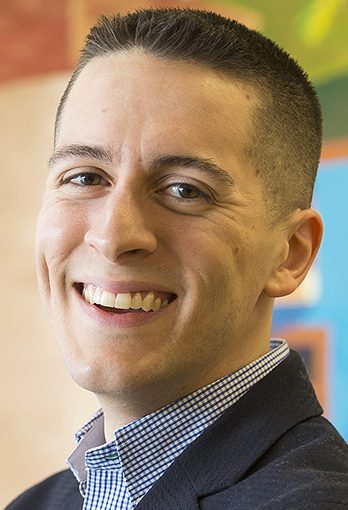Milwaukee’s southside has always been a place of transition. Stroll through the Walker’s Point neighborhood today, for example, and you’ll see and hear the sights and sounds of construction as once-abandoned buildings are torn down to be replaced with condominiums and ritzy restaurants. These changes, however, are part of a long history of transformation. Long referred to as Milwaukee’s Ellis Island, Walker’s Point has historically been a space where immigrants from around the world have arrived and found ways to make space for themselves in their new American home. Nowhere has this transformative placemaking been more evident than in the neighborhood’s Catholic parishes such as current-day Holy Trinity-Our Lady of Guadalupe Church.
Holy Trinity parish was originally established in 1850, just two years following Wisconsin’s admittance into the union. At the time, the state was still considered “mission territory” by episcopal leadership. Catholics on the city’s south side found it inconvenient to travel downtown to Old St. Mary parish, one of Milwaukee’s original Catholic congregations. In 1849, the founders of Holy Trinity — immigrants from southern Germany and Austria who had faced anti-Catholic and anti-immigrant bigotry in their settlement — led a procession from Old St. Mary’s to the site of their new church to lay a cornerstone on South Fourth Street, making Holy Trinity just the third Catholic church in Milwaukee. Over the next few decades, Holy Trinity would serve as a foundational parish for area Catholics, as Milwaukee became home to one of the largest German and Catholic populations in the United States.
Holy Trinity would again serve as a first-stop destination for new arrivals in the early 20th century. In the 1920s, parishioners opened their church to los primeros, Milwaukee’s first Mexican settlers, who settled in the shadow of Walker’s Point’s tanneries and foundries. White and Mexican Catholics worked together to establish the original Mexican Mission Chapel of Our Lady of Guadalupe in 1926, just two blocks away from Holy Trinity. The fellowship created in the establishment of this small Spanish-speaking mission served as a bridge between these two communities throughout the decade and in the years to follow.
The faith-based experiences the church offered the laborers and families who traveled from Mexico served as an escape from the difficult adjustment to life in this Midwestern industrial city. Despite facing racial discrimination in their places of employment and coercive assimilation efforts from the city’s settlement agencies, Mexicans found partners among Milwaukee’s Catholic clergy and white parishioners. The chapel they created together developed into a space where Mexican immigrants could negotiate their faith identities through familiar ethnic and religious practices and native language, ultimately working to affirm a sense of belonging in their new homes in the U.S. Midwest.
By the middle of the 20th century, much of Holy Trinity’s German- and Slavic-descent population had either fled to the suburbs or passed away, while its neighbor Guadalupe was grappling with overcrowding. A booming Mexican and Puerto Rican population had forced the parish to add a fourth Sunday service in their cramped facilities at a repurposed telephone company building. In 1965, the Archdiocese of Milwaukee proposed a solution: merging these two parish communities into one under the leadership of its Latino laity. On Aug. 28, 1966, hundreds of parishioners from the Latino Catholic parish of Our Lady of Guadalupe on Milwaukee’s south side embarked on a pilgrimage, much like their German predecessors more than 100 years earlier. Carrying a banner bearing the Virgin Mother’s image in the lead, congregants walked the six blocks separating Guadalupe and Holy Trinity Catholic Church to join the two congregations into one shared parish.
Just as their predecessors had transformed Holy Trinity into a communal space celebrating their ethnicity and faith, Our Lady of Guadalupe’s Latino members made their mark on the new parish space and the very character of the congregation. Female members formed a devotional community called Las Guadalupanas that celebrated the patron mother of Mexico, la Virgen de Guadalupe. Parishioners introduced a feast of Guadalupe celebrated with an Aztec dance during the Offertory of Mass, a fantastic display of 24 parish high school youths, dressed in colorful Aztec dress, who danced to ancient music as the sacramental gifts of wine and bread were presented at the altar. Parishioners introduced the Christmas custom of las posadas, as well as the Mexican tradition of Viacrucis en los hogares, a Lenten observance of the Stations of the Cross where parishioners would visit and celebrate Mass at 14 homes within walking distance of the church. By the early 1970s, the congregation’s favorite song to sing during Mass was “Misa Panamericana,” a mariachi song accompanied by trumpets, a Mexican vihuela and guitarrón that celebrated a growing pan-Latino identity across the national Catholic Church.
During the span of the 20th century, religious spaces like Holy Trinity-Our Lady of Guadalupe served as crucial locations for community formation and social activism for Milwaukee Latinos. In a 1999 interview, Mimi Soto, a lifelong parishioner and chairperson of the parish’s 150th anniversary committee, told the Walker’s Point Bulletin that the church had “been like a Rock of Gibraltar to the community” since its establishment. Soto noted that “the church is where the social action began” for many Latinos, a place where people of shared ethnic identity and common religious values could organize and fight for a shared cause. Throughout the late 20th and early 21st century, that “social action” work encompassed several initiatives, including multilingual education, alcohol and drug abuse intervention, immigration activism and campaigns for living-wage employment.
Today, Latinos continue to transform the landscape of Catholic Milwaukee as they nurture religious homes across the city and surrounding suburbs. Congregations like Holy Trinity-Our Lady of Guadalupe, however, will hold a special place in the hearts of many area Latinos, serving as what theologian Timothy Matovina has referred to as “enduring communities of faith.” In the face of constant transitions, this church anchors Milwaukee’s Latino and immigrant communities to their deep and rich religious history.

Sergio M. González
